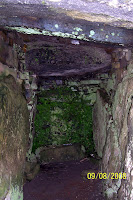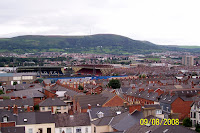I met with Cap’n Farrell and his money he was countin’.
I first produced my pistol then rattled forth my rapier,
Cryin’, "Stand and deliver, for there’s no-one here to save ya!”
Mush-a durum durrum da,
Whack fol the daddy-o. Whack fol the daddy-o,
There's whiskey in the jar!
WE FAREWELLED AGHADOE Cottage and Killarney, and drove off up the N71 and N21 to Limerick, then along the N7 to the M7 and Kildare, and onto the M50 that rings Dublin on the west side. From there, the N3 took us northwestward to Jordanstown, where we turned southwest, and so (after four hours or so driving) came to …
The Hill of Tara …
… (Teamhair in Irish, either “High Place” or, as scholars now believe, “Hill of the Dark Earth-Goddess”), was once a place of burial and ritual assembly, the supreme religious centre in pagan Ireland. It’s said that one hundred and forty-two High Kings reigned from there in prehistoric and historic times. There are more than thirty known earthen structures in the ritual landscape atop the Hill, forming an unbroken sequence spanning some 4,000 years from around 3500 BC up to the 6th or 7th Centuries AD.
 You get there from the carpark by walking the footpath to the Information Centre, formerly St Patrick’s church, under the stern eye of De Oul’ Shintleman himself (real name: Maewyn Succat. St Patrick was Welsh). His biographers claim that it was here he had his most famous victory over the pagan druids, during the reign of the 5th Century king Laoghaire, whose father Niall had sold him into slavery.
You get there from the carpark by walking the footpath to the Information Centre, formerly St Patrick’s church, under the stern eye of De Oul’ Shintleman himself (real name: Maewyn Succat. St Patrick was Welsh). His biographers claim that it was here he had his most famous victory over the pagan druids, during the reign of the 5th Century king Laoghaire, whose father Niall had sold him into slavery.
The hill was busy with tourists and sheep, and (in a different sense) with a remarkable set of mounds, hollows, ditches, and walls. At least as remarkable was the view, despite the cloudy and rather moist weather; on a fine day, half the counties of Ireland are supposedly visible from the top, which must be one of the reasons for its ancient sanctity.
 We crested the so-called Mound of the Hostages (Dumha na
We crested the so-called Mound of the Hostages (Dumha na  nGiall) in the King’s Fort, and gazed into the entrance of its passage tomb, where we could see the spiral forms of Neolithic art (perhaps 3,000 BC) carved into the orthostats (upright slabs). It is said—but a lot of things are said about Tara—that they represent the journey of the soul into and beyond death. The mound was used for burials over a period of 1500 or so years; excavation found the remains of many bodies (between 250 and 500) in layers beneath the passage, but the mound was very carefully restored when the excavations were completed.
nGiall) in the King’s Fort, and gazed into the entrance of its passage tomb, where we could see the spiral forms of Neolithic art (perhaps 3,000 BC) carved into the orthostats (upright slabs). It is said—but a lot of things are said about Tara—that they represent the journey of the soul into and beyond death. The mound was used for burials over a period of 1500 or so years; excavation found the remains of many bodies (between 250 and 500) in layers beneath the passage, but the mound was very carefully restored when the excavations were completed. We viewed the ring-mounded King Cormac’s House (Teach Cormaic) from inside and out, and saw the Stone of Destiny, the Lia Fáil, on top of the nearby mound called the Forradh, the Mound of Inauguration. Here (perhaps) the High Kings of Ireland were proclaimed and crowned, while the Stone roared with joy at their feet upon it, or at the touch of their chariot axles. It is from this stone that the divine race, the Tuatha de Danaan, named Ireland “Inis Fáil”. (But the Scots say it was taken from Ireland to Argyll by Kenneth MacAlpin, and became the Stone of Scone. Even at Tara, its original site and even its original shape are unknown. The stone that stands at Tara, five feet above the ground and seven feet below it, is the most phallic ancient stone in Ireland ...)
We viewed the ring-mounded King Cormac’s House (Teach Cormaic) from inside and out, and saw the Stone of Destiny, the Lia Fáil, on top of the nearby mound called the Forradh, the Mound of Inauguration. Here (perhaps) the High Kings of Ireland were proclaimed and crowned, while the Stone roared with joy at their feet upon it, or at the touch of their chariot axles. It is from this stone that the divine race, the Tuatha de Danaan, named Ireland “Inis Fáil”. (But the Scots say it was taken from Ireland to Argyll by Kenneth MacAlpin, and became the Stone of Scone. Even at Tara, its original site and even its original shape are unknown. The stone that stands at Tara, five feet above the ground and seven feet below it, is the most phallic ancient stone in Ireland ...)The weather had been chancy all day, and while Don was walking round the Teach Miodhchuarta, the so-called “Banqueting Hall” (a long, narow, banked enclosure which was probably a ceremonial avenue), there was a peal of thunder. We made it back to the car in time, but our drive northward to Belfast was punctuated by bursts of heavy rain.
We had intended to go to another neolithic site, ranking almost as high as Tara, Newgrange; but we heard from a guide at Tara that Newgrange closed at 5, and since it would be almost that by the time we got there, we saved it for another day.
 We’d booked ahead for Belfast, an apartment in Cordia Serviced Apartments. According to its postcode, it was quite central to Belfast, which suited our intention to see a little of the city as well as of the province. But when we’d navigated our way there (aided by Google Maps), it was so obviously not the right location for the apartments! We phoned the number on the reservation confirmation, and
We’d booked ahead for Belfast, an apartment in Cordia Serviced Apartments. According to its postcode, it was quite central to Belfast, which suited our intention to see a little of the city as well as of the province. But when we’d navigated our way there (aided by Google Maps), it was so obviously not the right location for the apartments! We phoned the number on the reservation confirmation, and  found the actual address was further out of town than we’d wanted. We found the place (on Lisburn Rd), but the first apartment we were sent to lacked several of the features we’d been promised, in particular an en suite and a view of the Black Mountains (it was on the wrong side of the building!); so we complained and got moved to a much nicer two-bedroom apartment on the top floor and on the opposite side; so we got our Black Mountains view after all, and a balcony to view it from!
found the actual address was further out of town than we’d wanted. We found the place (on Lisburn Rd), but the first apartment we were sent to lacked several of the features we’d been promised, in particular an en suite and a view of the Black Mountains (it was on the wrong side of the building!); so we complained and got moved to a much nicer two-bedroom apartment on the top floor and on the opposite side; so we got our Black Mountains view after all, and a balcony to view it from!Having settled in, but having little by way of food and drink, we made it to the next-door Tescos (dashing through the rain) just in time to buy dinner and supplies before they closed. Then we blobbed in front of the TV (watching I Robot); and saw about the record-breaking flooding on the roads around Dublin, not more than half an hour after we’d passed through. Shades of our arrival a week earlier!
No comments:
Post a Comment